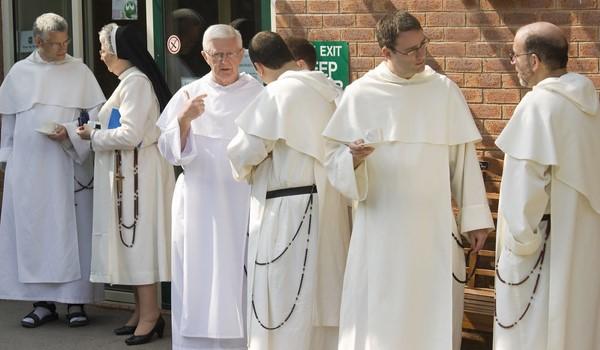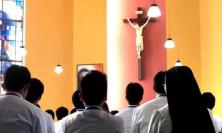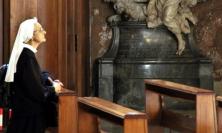Shared via Creative Commons (CC BY-NC-ND 2.0)
In this first instalment of a two-part article, Cardinal Michael Czerny SJ reviews essential elements of Vatican II’s renewal of consecrated life and examines the development of magisterial teaching in the sixty years since. In describing the ‘Copernican revolution for consecrated life’ that the Council represented, he lays the foundations on which his later analysis of the challenges to religious life today, particularly as they are viewed through the lens of Fratelli tutti, will build.
This article in two parts begins with essential elements of Vatican II’s renewal of the consecrated life and the subsequent magisterium. The second part then analyses some of today’s challenges to men and women in religious orders, which become, in Francis’ teaching and most recently in Fratelli tutti, so many ‘signs of the times’ which invite religious to deepen their sequela Christi and wholeheartedly take up the Church’s mission in the world.
1.1 Consecrated Life at Vatican II
The Second Vatican Council represented a Copernican revolution for consecrated life. Its decrees went far beyond what had been the hopes and expectations of those directly involved in preparing for the Council.
Rather than a reform of institutes or an affirmation of the ‘superior dignity’ of religious life over marriage, the Council Fathers ventured on a completely new path: they redefined religious life on the basis of the category of ‘consecration’, thus laying the foundations for the post-Conciliar development of a ‘theology of charism’ and a ‘mysticism of the consecrated life’.
Lumen gentium constitutes the watershed of this renewed approach. Renewal would no longer be conceived as a disciplinary intervention aimed at producing decrees of ‘reform’, but rather be directed at appreciating religious life in a broader and more complete ecclesiological framework.
1.2 Church roots of consecrated life
In Lumen gentium, the recovery of the doctrine on ‘the common priesthood of the faithful’ (LG §10) made it possible not only to re-evaluate the importance of the laity, but also to specify the role and mission of religious men and women in the life of the Church.
The Council takes baptism as its starting point, as the mystery and fundamental dimension of Christian existence. Then, with the profession of the evangelical counsels of poverty, chastity and obedience, those who consecrate themselves to the service of God in the Church can derive ‘more abundant fruit from this baptismal grace’ (LG §44).
Lumen gentium (ch 6) lays out four distinctive dimensions which come together in the Council’s meditation on consecrated life: ecclesial vocation; human development; reality and sign; and, finally, charismatic nature.
1) Ecclesial vocation: By declaring that the mission and spiritual life of religious is ‘devoted to the welfare of the whole Church’ (LG §44), the Council specifies both their belonging and destination. Consecrated life constitutes a path of perfection not marked by individualism, but clearly rooted ecclesially and communally.
The choice of the evangelical counsels represents for the individual, and for the whole Church, an opportunity for enrichment and a privileged ‘place’ where grace is manifested. Moreover, the Council emphasises the importance of the experiential and testimonial heritage that the consecrated life brings to the Church. Its manifold richness represents a true and proper ‘spiritual capital’ for the members of the various orders, religious institutes and societies of apostolic life, and for ‘the whole Body of Christ’ (LG §28).
2) Human development: Alongside the concept of the Church as ‘people of God’, the Council’s Copernican revolution revolves around the recognition of each person’s dignity and rights. This change of view is also reflected in religious life, underlining the ‘rights’ of the consecrated person such as to education, to psycho-affective maturation, to gender equality, to the enhancement of personal talents, to respect for the person (regardless of the institutional role held). The result is a positive reading of consecrated life which focuses not on the renunciations which are required but on the ‘benefits’ for those who decide to embrace it (LG §46).
3) Reality and sign: Consecrated life is recognised in its reality as a sign, above all because of the eschatological tension that runs through it. Chastity, poverty and obedience, when vowed and lived, constitute an anticipation of the condition of perfect and definitive communion to which all the children of God will be introduced in the last times. This is because of the intrinsically relational nature of the vows. By giving themselves to God in this particular way, religious women and men can acquire a different freedom in how they relate to themselves, to material goods, and to others. Instead of fleeing from the world (fuga mundi) and becoming ‘strangers to their fellowmen or useless citizens of this earthly city’ (LG §46), religious embark on a way of engaging with history, of living in time, of ministering and serving.
4) Charismatic nature: In place of the paradigm of renunciation, consecrated life is seen by the Council as a way of participating in the response of the Christian people to the history of salvation. Moreover, the consecrated life does not belong to the institutional structure of the Church, nor does it represent an ‘intermediate state between the clerical and lay state’ (LG §43). Instead, it constitutes a special gift with which the Spirit has enriched the Church and characterised its charismatic structure, inasmuch as it ‘undeniably belongs to its life and holiness’ (LG §44).
1.3 Called to ‘spread the Kingdom of God’
In 1965, barely a year after Lumen gentium, the Council’s reflection on the consecrated life was enriched by the decree Perfectae caritatis on the appropriate renewal of religious life.
The decree first makes explicit the Christological foundation of religious life (PC §1) and indicates the following of Christ as the ‘highest rule’ and the ‘ultimate norm’ (PC §2a) that governs it. Its primary purpose is union with God, to which both contemplation and apostolic zeal must be directed. From the desire for a more intense communion with Christ, derives the ‘apostolic love by which they strive to be associated with the work of redemption and to spread the kingdom of God’ (PC §5).
The multiple forms of consecrated life − contemplative, active, monastic and lay religious life (PC §7-11) – show with how great a ‘variety of gifts’ the Spirit embellishes the Church (cf. PC §1).
For this reason, the decree recommends that each institute acquire knowledge of its own origins and history. The recovery of ‘the spirit and special aims’ proper to each founder and first companions will help to attune the original charismatic intuition to ‘the social conditions of the times they live in’ and ‘the needs of the Church’ (PC §2b, 2d).
The decree is also structured by the renewed awareness matured by the Council Fathers with respect to common life. What binds religious together is love for God, and this unity lived daily together becomes a sign that ‘manifests the coming of Christ’ (PC §15). Indeed, the very fruitfulness of religious life depends on the quality of life in common, since fraternal unity is ‘a source of great apostolic energy’ (PC §15). Nowadays young people discerning a religious vocation often testify that it is the community life and spirit that they find most attractive.
1.4 Charisms of the founders
In the apostolic exhortation Evangelica testificatio of 1971, Pope St Paul VI seeks to respond respectfully and gracefully to the climate of ‘anxiety’ (ET §2) that followed the Second Vatican Council. He raises questions towards a correct hermeneutic of its declarations on religious (ET §6). He reiterates the importance of rediscovering ‘the charism of your founders’ (ET §11), because on its identification depend those ‘fundamental options’ which make it possible ‘continually … to revitalize external forms with this interior driving force’ (ET §12).
Paul VI includes, in relation to the vow of poverty, a reference to the preferential option for the poor made by the Council (LG §8; GS §1). Responding to the ‘cry of the poor’, to their ‘appeal as God’s privileged ones’ (ET §17), becomes a constant call to love and to shun selfishness, a call for conversion of mind and heart and ‘for liberation from all temporal encumbrances’ (ET §17). Religious are called to live their poverty, like the Son of Man who ‘has nowhere to lay his head’ (Lk 9:59), as a deliberately passing, precarious and generous existence.
Above all, Pope Paul recommends joy as ‘the greatest possible expansion of your life in Christ’ (ET §55), as a witness for religious to give to those who have ‘lost sight of the meaning of their lives and are anxiously searching for the contemplative dimension of their being’ (ET §45).
1.5 A path of uncreated beauty
The 1974 Synod of Bishops was also decisive in guiding the renewal of consecrated life. The bishops emphasised the essential missionary character of the Church and the duty of each member to bear witness to Christ throughout the world. Later, Paul VI used the Synod’s propositions in drafting the Apostolic Exhortation Evangelii nuntiandi.
In those years, the Church was going through various vicissitudes, including the tensions that had arisen among religious and institutes. There were two opposing tendencies: those who would have wished consecrated life to return to earlier conservative approaches, and those who hoped that the impulse for innovation would not be exhausted. There are examples of conflict mainly over issues discussed in the Council regarding traditional religious garb, scheduled prayer, governance, and innovative ministries; and of tensions over liberation theology and the involvement of religious in revolutionary activities.
The election of St John Paul II as Bishop of Rome on 16 October 1978 inaugurated a new phase in the renewal of consecrated life, characterised by an effort to codify the theological, ecclesial and orientating insights of the Council.
The conflicts and tensions, the growing numerical and institutional crises of consecrated life, and other concerns such as these convinced the pope of the need for a return to a firmer ‘sense of the institution’. Interventions by the Holy See occurred, such as the appointment of a Papal Delegate for the Jesuits (1981-83). While on the one hand the promulgation of the new Code of Canon Law in 1983 effectively put an end to the period of post-conciliar experimentation, there was on the other a desire to give new emphasis to the theology of special consecration.
Thirty years after Perfectae caritatis, the Apostolic Exhortation Vita consecrata (1996) represents a certain point of arrival in the journey made by the Church after the Council.
Vita consecrata, a vast and rich document, is full of original insights. The Exhortation seems guided by the intention to develop more adequately the pneumatological implications of the sequela Christi (‘following of Christ’) brought about by the choice of the evangelical counsels. In fact, it states that ‘the call to the consecrated life is closely linked to the working of the Holy Spirit’ (VC §19). The gospel account of the Transfiguration (VC §15) is taken as the biblical icon which illuminates religious life and enables it to be appreciated as a philokalia: the Holy Spirit overshadows consecrated persons, makes them perceive the divine grace and beauty which radiate from the humanity of Christ.
The responsibility of participating in the Church’s evangelising mission is also placed in a pneumatological perspective, pointing out that ‘the first missionary duty of consecrated persons is to themselves, and they fulfil it by opening their hearts to the promptings of the Spirit of Christ’ (VC §25).
The second part of the document focuses on the value of the consecrated life as a sign and instrument of communion.[1] In particular, community life is proposed as an ‘eloquent sign of ecclesial communion’ and a ‘God-enlightened space’ in which to experience the Risen Lord (VC §42). For this reason, religious women and men should appear in the eyes of the world as ‘experts of communion’, as sharing faith and daily life with others makes them ‘witnesses and architects’ of unity (VC §46).
It is in the context of this articulated reflection on the vocation and mission to communion, to think with the Church (sentire cum Ecclesia), that we find another original indication of the Exhortation: the invitation to establish closer and more incisive relationships of exchange and collaboration with the laity (VC §54). In order to make ‘more effective [their] response to the great challenges of our time’ (VC §54), religious should accept and guide the contribution of laity. For example, when they can no longer manage their Catholic hospitals, sisters ‘translate’ their vision and spirituality into a strong mission statement to guide lay boards.
The last part of the document is an appeal to religious to become witnesses of charity: in the promotion of the dignity of the person (VC §82), in the service to life (VC §83), to the truth (VC §96), to culture and communication (VC §97-98), and to dialogue (VC §100-103).
These clear socio-pastoral guidelines conclude our review of the Council’s impact and subsequent magisterium on religious life up to our own day.
This is the first part of an adaptation of a longer, more detailed article ‘Religious Life from Vatican II to Fratelli Tutti’ published in Review for Religious, 1, no. 1 (Summer 2021): 87-106 and available in English, French, Italian, Portuguese and Spanish at https://www.reviewforreligious.com/fromthejournal-czerny/
Cardinal Michael Czerny SJ serves as an Under-Secretary for the Migrants and Refugees Section of the Dicastery for Promoting Integral Human Development. Previously, he held numerous leadership positions in the Jesuits, including heading the Social Justice Secretariat at the Jesuit General Curia and founding the African Jesuit AIDS Network. He can be reached at [email protected].
[1] In it we hear echoes of the document Fraternal Life in Community. Congregation for Institutes of Consecrated Life and Societies of Apostolic Life, ‘Congregavit nos in unum Christi amor’, 2 February 1994.






